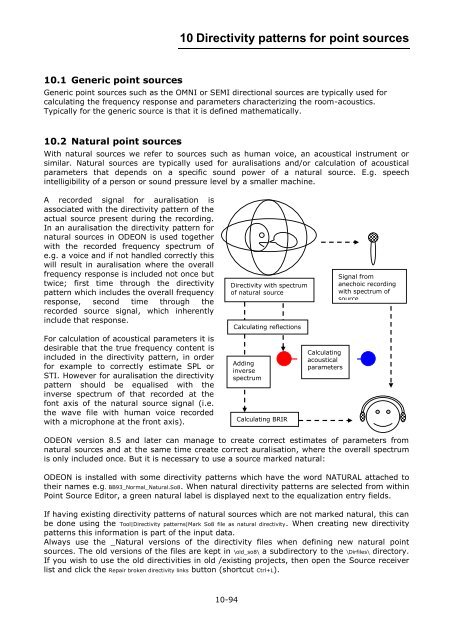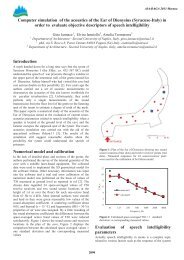Download - Odeon
Download - Odeon
Download - Odeon
Create successful ePaper yourself
Turn your PDF publications into a flip-book with our unique Google optimized e-Paper software.
10 Directivity patterns for point sources<br />
10.1 Generic point sources<br />
Generic point sources such as the OMNI or SEMI directional sources are typically used for<br />
calculating the frequency response and parameters characterizing the room-acoustics.<br />
Typically for the generic source is that it is defined mathematically.<br />
10.2 Natural point sources<br />
With natural sources we refer to sources such as human voice, an acoustical instrument or<br />
similar. Natural sources are typically used for auralisations and/or calculation of acoustical<br />
parameters that depends on a specific sound power of a natural source. E.g. speech<br />
intelligibility of a person or sound pressure level by a smaller machine.<br />
A recorded signal for auralisation is<br />
associated with the directivity pattern of the<br />
actual source present during the recording.<br />
In an auralisation the directivity pattern for<br />
natural sources in ODEON is used together<br />
with the recorded frequency spectrum of<br />
e.g. a voice and if not handled correctly this<br />
will result in auralisation where the overall<br />
frequency response is included not once but<br />
twice; first time through the directivity<br />
pattern which includes the overall frequency<br />
response, second time through the<br />
recorded source signal, which inherently<br />
include that response.<br />
For calculation of acoustical parameters it is<br />
desirable that the true frequency content is<br />
included in the directivity pattern, in order<br />
for example to correctly estimate SPL or<br />
STI. However for auralisation the directivity<br />
pattern should be equalised with the<br />
inverse spectrum of that recorded at the<br />
font axis of the natural source signal (i.e.<br />
the wave file with human voice recorded<br />
with a microphone at the front axis).<br />
Directivity with spectrum<br />
of natural source<br />
Calculating reflections<br />
Adding<br />
inverse<br />
spectrum<br />
Calculating BRIR<br />
Calculating<br />
acoustical<br />
parameters<br />
Signal from<br />
anechoic recording<br />
with spectrum of<br />
source<br />
ODEON version 8.5 and later can manage to create correct estimates of parameters from<br />
natural sources and at the same time create correct auralisation, where the overall spectrum<br />
is only included once. But it is necessary to use a source marked natural:<br />
ODEON is installed with some directivity patterns which have the word NATURAL attached to<br />
their names e.g. BB93_Normal_Natural.So8. When natural directivity patterns are selected from within<br />
Point Source Editor, a green natural label is displayed next to the equalization entry fields.<br />
If having existing directivity patterns of natural sources which are not marked natural, this can<br />
be done using the Tool|Directivity patterns|Mark So8 file as natural directivity. When creating new directivity<br />
patterns this information is part of the input data.<br />
Always use the _Natural versions of the directivity files when defining new natural point<br />
sources. The old versions of the files are kept in \old_so8\ a subdirectory to the \Dirfiles\ directory.<br />
If you wish to use the old directivities in old /existing projects, then open the Source receiver<br />
list and click the Repair broken directivity links button (shortcut Ctrl+L).<br />
10-94

















